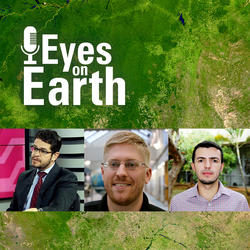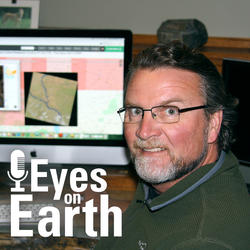National Land Imaging Program
Multimedia
Eyes on Earth Episode 40 – Landsat Collection 2
Landsat data is more useful today than at any other point in its nearly 50-year history. The USGS Collections strategy is a major reason why. Landsat Collections align and correct satellite acquisitions from 1972 through the present to make the data easier to work with through time. The USGS has now released Collection 2, an upgrade that improves geometric accuracy,
Image of the Week - Dam Failure in Uzbekistan
The western wall of Uzbekistan's Sardoba Reservoir breached on May 1st, 2020 after a week of heavy rain. Thousands were evacuated as water rushed north into farmland and villages across the central Asian country and into neighboring Kazakhstan. Imagery from Europe's Copernicus Sentinel-2 satellite shows water pooling across a wide area. In the May 4th image 3 days after
Image of the Week - Petermann Glacier 2020 Update
Petermann Glacier in northwestern Greenland is known to generate large icebergs, most notably in 2010 and 2012. Another large iceberg may be forming now. A new rift was spotted on the glacier in 2017. Since then, imagery from both Landsat and Europe's Copernicus Sentinel-2 satellites show the rift lengthening and meeting up with and older crack. The potential iceberg could
Outreach EROS Overview
This is EROS.
It's located just north of Sioux Falls in South Dakota in the United States on the planet Earth!
EROS stands for Earth Resources Observation and Science. It's a federal government facility where over 600 talented women and men work together to capture, store, and study images of the Earth taken from high above. Our Earth is always changing, and
Eyes on Earth Episode 39 – Brazil’s Water Use
Brazil is a fascinating study in water use. Brazil uses roughly 72 percent of its water for irrigated agriculture, and its herds of cattle, pigs and poultry are among the largest in the world. Water management teams from that country’s National Water Agency have worked in recent years with researchers from the USGS EROS Center to learn how to map, and therefore more
Eyes on Earth Episode 38 – Time Series Analysis with Landsat
In the past, remote sensing scientists looked for change on the Earth’s surface primarily by comparing one Landsat image to another. Today, open access to Landsat data, high-performance and cloud computing capabilities and sophisticated algorithms can be used to scan the entirety of the archive for change, enabling researchers to learn more about how the landscape shifts
Eyes on Earth Episode 36 – International Charter Turns 20
When a disaster like a hurricane, flood or major wildfire hits a remote part of the world, the International Charter Space and Natural Disasters springs into action. The Charter’s members collect and distribute satellite-derived data that documents the damage, as well as derived products like as fire perimeter or structural damage maps – all at no cost to national
Eyes on Earth Episode 37 – Insuring West Africa’s Crops
The Green Revolution leaned on fertilizers, drought-resistant seeds and other modern innovations to boost agricultural production across much of the planet in the second half of the 20th Century. But many of those innovations never reached West Africa, partially because the lack of social safety nets and crop insurance made such investments too risky. On this episode of
Image of the Week - Summer Fires Rage in California
As fire season continues in the western United States let's look back at a number of incidents tracked by officials across California in August. These fires were captured during the day by Landsats 7 and 8, in natural color bands of the visible spectrum. Landsat sensors also record infrared wavelengths revealing burn scars and active fires. Natural color images show smoke
Eyes on Earth Episode 35 – Watching the Water Supply with OpenET
Evapotranspiration is the process by which water transpires from the leaves and stems of plants and evaporates from the Earth’s surface. ET is an important metric for managing water use, but data availability has long been an issue. On this episode of Eyes on Earth, we talk about OpenET, a bold initiative whose goal is to improve water management by making that water
Image of the Week - Time Travel by Permafrost
In Russia's Extreme North, a widening chasm known as the Batagaika Crater provides a unique opportunity to study the past. Early declassified aerial images recorded the crater's growth in the 1960s and 1970s followed by multispectral sensor imagery captured by Landsat and Sentinel satellites, building a continuous view over the last 60 years. But the gash in the ground
Eyes on Earth Episode 32 - Lunar Calibration
Calibration teams at the USGS EROS Center use a variety of methods to make sure the data collected by Landsat satellites are an accurate representation of the Earth’s surface. They’re constantly comparing new imagery to old, tweaking algorithms to correct issues that might emerge, and using unchanging Earth surface sites and on-the-ground readings to check for consistency













